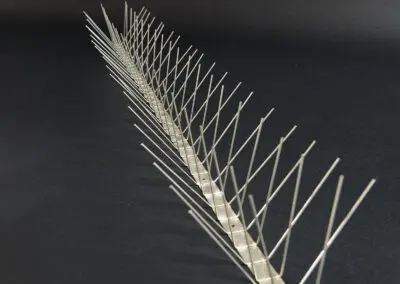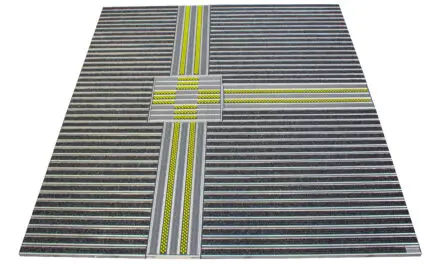Pigeon repellent spikes with plastic base
The plastic base becomes brittle over time due to the influence of light and weathering. As a result, the thin spikes lose their stability and can easily be pushed apart by the pigeons. Instead of keeping the birds away, this creates an undesirable effect: the weakened spikes provide ideal conditions for pigeons to build their nests.
Pigeon barricade with plastic dovecot
Plastic doves, which are intended to deter pigeons by simulating a natural enemy, often prove to be ineffective in practice. The pigeons quickly realize that these dummies pose no real danger, which is why they ignore them or even use them as a resting place.
Stainless steel pigeon spikes from rotec
Dear readers,
Pigeons are a widespread problem in urban areas. Their settling on buildings not only leads to unsightly soiling, but also poses a considerable health risk. In this article, we would like to present the advantages of pigeon repellent systems made entirely of stainless steel and compare them with alternative spikes with a plastic base. We also shed light on the health risks posed by pigeon droppings and why reliable pigeon repellent is essential.
Why stainless steel pigeon spikes?
Stainless steel spikes Pigeon repellent systems have been a proven means of effectively keeping pigeons away from buildings for many years. There are various materials from which these spikes can be made - mainly stainless steel and plastic. Why choose stainless steel?
1. durability and resistance
Stainless steel spikes provide a stronger physical barrier and are therefore more effective at repelling pigeons. The robust stainless steel spikes are unpleasant for the birds and successfully deter them from settling on buildings. This not only reduces the amount of cleaning required, but also protects the building fabric from the aggressive properties of pigeon droppings.
2. higher effectiveness
Due to their robust construction, stainless steel spikes represent a stronger physical barrier for pigeons. The harder metal spikes are more uncomfortable for the birds and therefore more effective in repelling them. This significantly reduces the likelihood of pigeons settling anyway.
Use and advantages of pigeon repellers
| Feature | Stainless steel | Plastic base |
|---|---|---|
| Durability | Very high | Short-lived |
| Weather resistance | Excellent | Limited |
| Deterrent effect | High | Medium |
| Weight | Higher | Light |
| Costs | Higher | Lower |
35 years of experience speak for stainless steel
After 35 years of experience with pigeon deterrent systems, I can answer the question of whether pigeon deterrents made entirely of stainless steel are more suitable for pigeon deterrence than those with a plastic base:
Spikes made entirely of stainless steel are the better choice.
A major disadvantage of spikes with a plastic base is that the plastic base becomes porous over time due to light and sunlight. This causes the spikes to loosen and the pigeons can push the spikes apart, creating gaps. Instead of keeping the pigeons away, the opposite effect occurs - the birds nest in the resulting gaps and the problem worsens. This phenomenon can be observed very frequently at the stations of the Berlin S-Bahn.
This is not possible with spikes that are made entirely of stainless steel. At rotec, we use a 2 mm thick wire that is not only strong enough to fulfill its function permanently, but is also designed so that the spikes are not sharp. This ensures that the pigeons do not injure themselves, which is both effective and animal-friendly.
Health risks from pigeon droppings
It's not just the dirt that pigeons leave behind, but also the potential health risks posed by their droppings. Pigeon droppings can contain a variety of pathogens that can be dangerous to humans. The most common risks are
Diseases of the respiratory tract:
Inhaling dried pigeon droppings can cause diseases such as histoplasmosis or cryptococcosis.
Fungal infections:
Various types of fungi in pigeon droppings can cause serious infections.
SalmonellosisPigeon droppings can contain salmonella, which can lead to gastrointestinal illnesses.
Allergic reactions:
Contact with pigeon droppings can trigger allergic reactions in sensitive people.
Another crucial aspect when selecting pigeon spikes is animal welfare compliance. Stainless steel spikes from rotec are designed to effectively repel pigeons without causing them unnecessary pain or injury. The spikes have no sharp points that could injure the animals. They are also positioned in such a way that they prevent the pigeons from settling down without causing a direct confrontation.
Why ultrasound and bird of prey dummies do not work
In addition to physical defense systems such as spikes, methods such as ultrasonic devices and dummy birds of prey are often advertised for pigeon deterrence. However, from my experience and supported by scientific studies, I can say that both methods are absolutely ineffective.
Ultrasonic devices:
It is claimed that these devices can drive pigeons away by using sound frequencies that are unpleasant for them. Studies such as the one by Jenni-Eiermann
(Jenni-Eiermann, Susanne & Heynen, Daniela & Schaub, Michael. (2014). Effect of an ultrasonic device on the behavior and the stress hormone corticosterone in feral pigeons. Journal of Pest Science. 87. 10.1007/s10340-014-0553-y)
show, however, that ultrasound has no lasting effect on the behavior of pigeons. The birds quickly become accustomed to the sound and ignore it. The effect is therefore not only small, but practically non-existent in practice.
Bird of prey dummies:
Dummy birds of prey, such as artificial ravens, owls or falcons, are intended to deter pigeons by simulating a natural enemy. Here too, practice has shown that the birds quickly recognize that these dummies pose no real danger. The dummies are ignored or even used as a resting place.
Conclusion
Pigeon spikes made entirely of stainless steel are the best choice when it comes to effective, durable and aesthetically pleasing pigeon repellent. Despite the higher purchase costs compared to spikes with a plastic base, they pay for themselves through their durability and greater effectiveness. In view of the health risks posed by pigeon droppings and the requirements of animal welfare, investing in high-quality stainless steel spikes from rotec is the best decision for protecting your building.
At rotec, we not only offer you high-quality products, but also the necessary expertise to help you select and install the ideal pigeon control solution. Trust in our 35 years of experience and rely on quality that convinces.
Contact
Further information on rotec pigeon deterrent systems can be found on our website:
www.rotec-berlin.de and in our Online store
We wish you a pleasant week
Karl Marx







0 Comments